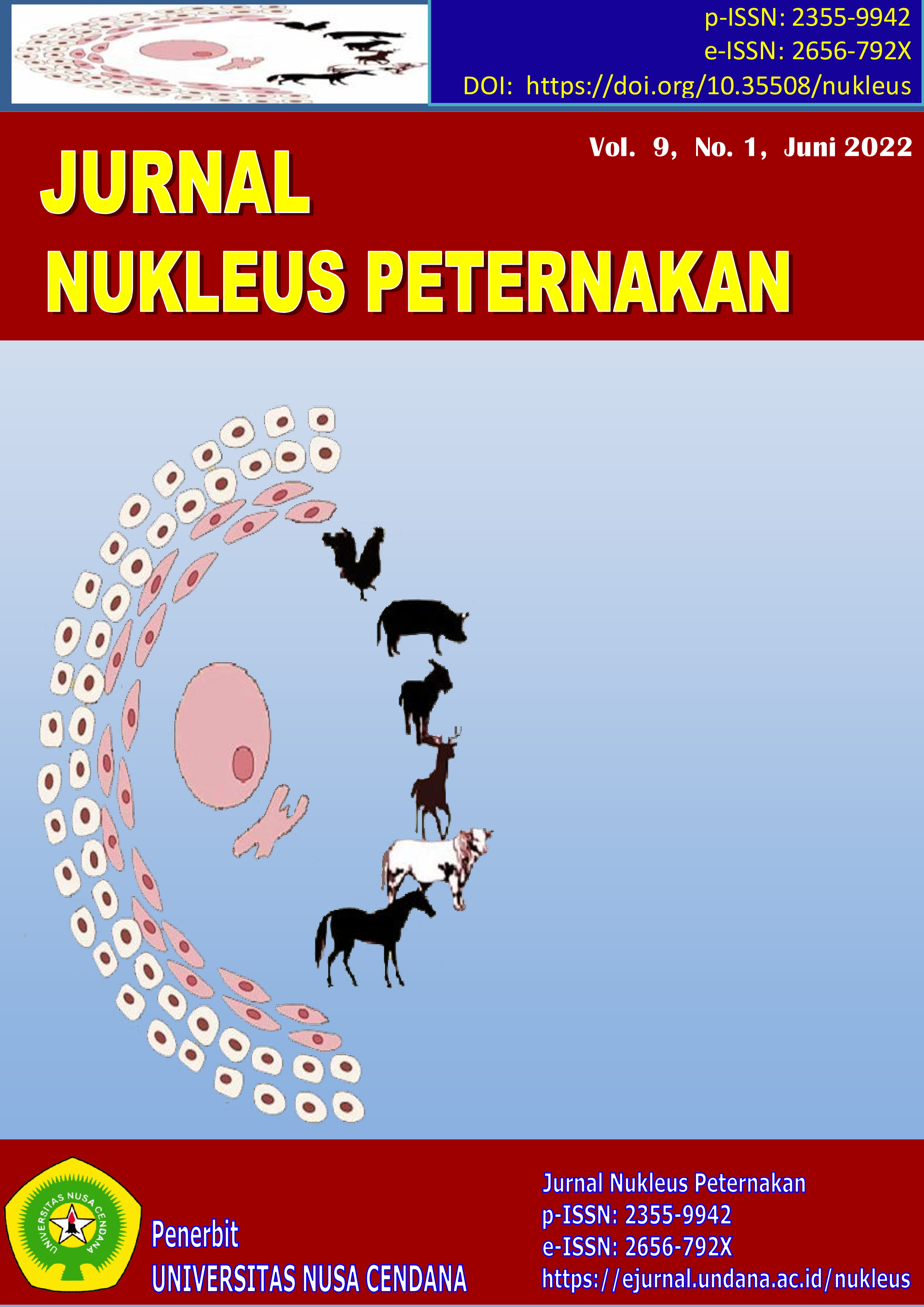KUALITAS BAKSO SAPI YANG DIOLAH DENGAN TEPUNG SORGUM MERAH (Sorghum bicolor L. Moench) SEBAGAI PENGGANTI TEPUNG TAPIOKA SELAMA MASA SIMPAN (Quality of beef meatballs which were proceded with red sorgum flour (Sorghum bicolor L. Moench) as a tapioca.....
Abstract
This study aims to determine the quality of beef meatballs processed with red sorghum flour as a substitute for tapioca flour during the shelf life. This study used a completely randomized design with 5 treatments and 4 replications. The treatments consisted of TS0 = 100% tapioca, TS25 = 25% red sorghum flour, TS50 = 50% red sorghum flour, TS75 = 75% red sorghum flour; TS100 = 100% red sorghum flour. Furthermore, the variation of storage time is 1 day and 30 days. The variables observed were organoleptic (color, aroma, taste), TPC, fat oxidation and elasticity. The results of statistical analysis showed that the use of red sorghum flour as a substitute for tapioca flour up to 100% did not change the color of the meatballs at 1 day of storage, but at 30 days of storage the color of the meatballs darkened, the aroma of the meatballs became on either 1 day or 30 days of storage (P <0.01), the meatball taste score at 1 day of storage decreased and at 30 days the meatball taste score was between very dislike to dislike (P<0.05), the elasticity score decreased from very chewy to not chewy score (P< 0.01), while at 30 days of storage the elasticity score of the meatballs was the same, namely not chewy. The treatment had a very significant effect (P<0.01) on TPC and fat oxidation. This study concluded that the higher the percentage of replacement of red sorghum flour decreased the organoleptic qualities such as darkening of the color, the decrease in aroma, taste and elasticity of the meatballs, the TPC (Total Plate Count) number. and fat oxidation increased from 1 day to 30 days of storage.
Downloads
References
Dicko MH, Gruppen H, Traore AS, Voragen AGJ, van Berkel WJH. 2006. Phenolic compounds and related enzymes as determinants of sorghum for food use. Biotechnology and Molecular Biology Review 1(1): 21-38.
Djuma AW. 2014. Effect Frequency Fryngonperoxide Number to Cooking Oil in Packaging. Jurnal Info Kesehatan 13(2): 797-803.
Flick GJ, Hong GP, Knobl GM. 1992. Lipid Oxidation of Seafood During Storage. Dalam A.J. St. Angelo (Editor). Lipid Oxidation in Food. American Chemical Society, Washington.
Kuniardi M, Andriani M. Faturohman F. Damayanti E. 2013. Karakteristik Fisikokimia Tepung Biji Sorgum (Sorghum bicolor L.) Terfermentasi Bakteri Asam Laktat Lactobacillus acidophilus. Agritech 33(3): 289-295.
Montolalu S, Lontaan N, Sakul S, Mirah AD. 2013. Sifat fisiko-kimia dan mutu organoleptik bakso broiler dengan menggunakan tepung ubi jalar (Ipomoea batatas L). Jurnal Zootek 32(5): 158-171.
Narsih, Yunianta, Harijono. 2008. Studi Lama Perendaman dan Lama Perkecambahan Sorgum (Sorghum bicolour L. Moench) Untuk Menghasilkan Tepung Rendah Tanin dan Fitat. Jurnal Teknologi Pertanian 9(3): 173-180.
Schober TJ, Bean SR dan Boyle DL. 2007. Glutenfree Sorghum Bread Improved By Sourdough Fermentation: Biochemical, Rheological, And Microstructural Background. J. Agric. Food. Chem 55: 5137-5146.
Siller ADP. 2006. In Vitro Starch digestibility and estimated glycemic index of sorghum products. Thesis. Texas: Food Science and Technology, Texas A & M University.
Suarni, Firmansyah IU. 2013. Struktur, Komposisi Nutrisi dan Teknologi Pengolahan Sorgum. Di dalam: Sorgum Inovasi Teknologi dan Pengembangan. Balai Penelitian.
Suprapto dan R. Mudjisihono. 1987. Budidaya dan Pengolahan Sorgum. Jakrata: Penebar Swadaya.
Tarwotjo LS, Hartini S, Soekirman S, Sumartono. 1971. Komposisi tiga jenis bakso di Jakarta. Akademi Gizi. Jakarta.
Winarno FG; Birowo AT. 1988. Gula dan Pemanis Buatan di Indonesia. Sekretariat Dewan Gula Indonesia. Jakarta.
Wirawan Y, Rosyidi D, Widyastuti ES. 2016. Pengaruh Penambahan Pati Biji Durian (Durio zibethinus Mur) Terhadap Kualitas Kimia dan Organoleptik Bakso Ayam. Jurnal Ilmu dan Teknologi Hasil Ternak 11(1): 52-57.
Zhang Z, Whatley CC, Corke H. 2002. Biochemical Changes During Storage of Sweet Potato Roots Differing in Dry Matter Content. Postharvest Biology and Technology 24: 317-325.
Copyright (c) 2022 JURNAL NUKLEUS PETERNAKAN

This work is licensed under a Creative Commons Attribution-NonCommercial-NoDerivatives 4.0 International License.
 Gerfasius Ninu(1*)
Gerfasius Ninu(1*)





.jpg)





